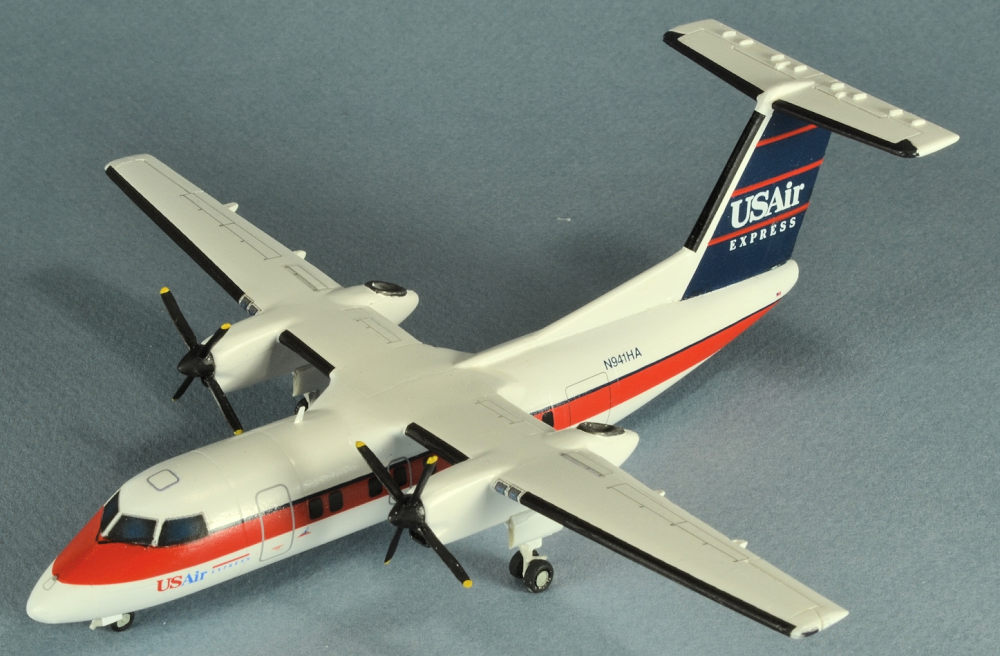
Welsh Models 1/144 DeHavilland Dash-8-100
| KIT #: | SL289R |
| PRICE: | £39.27 |
| DECALS: | one option |
| REVIEWER: | Ben Brown |
| NOTES: | Flight Path and Nazca decals. |

| HISTORY |
The De Havilland Dash-8 was developed in the early 1980s as an alternative to the short takeoff Dash-7, since most operators wanted the lower operational costs of a twin-engine aircraft and didnít need the Dash-7ís short field capabilities. De Havilland used the Dash-7ís high-wing, T-tail layout for the new aircraft, but chose two Pratt & Whitney PW120 1800 hp engines, instead of the Dash-7ís four smaller PT-6s. The Dash-8 had the lowest operating costs of any commuter airplane during that time. It was faster than the Dash-7, and could operate out of a 3000 ft runway (the Dash-7 only required 2200 ft). Henson Airlines, renamed Piedmont Airlines in 1993 to protect the Piedmont brand name, was the first US customer for the Dash 8, receiving their first 39 passenger Dash-8-100 in 1984. In 1989, the 50-seat -300 entered service. It was 11 ft longer, with a longer wingspan, and more powerful engines. The -200 was basically a -100 with the 300ís engines for better performance.
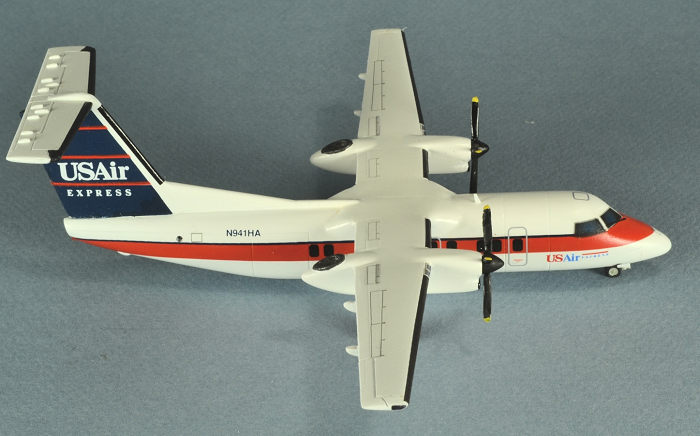 My own
experience with the Dash-8 began when Henson Airlines hired me in 1991. Henson
didnít have a full-motion simulator, so all training was done in the airplane.
With its high wing and T-tail, the Dash-8 looked huge sitting on the ramp. At
the time, I hadnít flown anything larger than an 8-passenger King Air 100, where
you sit just a few feet forward of the airplaneís pitch axis. With the Dash-8ís
considerably longer fuselage, every little pitch change translated to a lot of
vertical motion in the cockpit, and at first I felt like I was riding a fast
elevator! Fortunately, my instructor, Capt. Rodriguez, was very patient and had
a strong stomach, and I eventually got everything sorted out.
My own
experience with the Dash-8 began when Henson Airlines hired me in 1991. Henson
didnít have a full-motion simulator, so all training was done in the airplane.
With its high wing and T-tail, the Dash-8 looked huge sitting on the ramp. At
the time, I hadnít flown anything larger than an 8-passenger King Air 100, where
you sit just a few feet forward of the airplaneís pitch axis. With the Dash-8ís
considerably longer fuselage, every little pitch change translated to a lot of
vertical motion in the cockpit, and at first I felt like I was riding a fast
elevator! Fortunately, my instructor, Capt. Rodriguez, was very patient and had
a strong stomach, and I eventually got everything sorted out.
The Dash-8 wasnít the fastest commuter in the air, an advantage when you get paid by the hour, but it had a big, roomy cockpit, and the later models had fairly comfortable adjustable seats. There was even a nice spot on the instrument panel to rest your foot when the autopilot or the other pilot was flying the plane. It had a very good RNAV area navigation system (this was in the days before GPS) with a display that could overlay your course with the weather radar, so you could plan your way through that big line of thunderstorms in your path. When you took over a plane from another crew, you could tell how bad the thunderstorms were by the fingerprints on the radar screen. Our Dash-8s were also fitted with an auxiliary power unit, a small turbine engine in the aft fuselage that supplied electricity and air for the air conditioning system while the engines were shut down. It kept the interior relatively cool during the hot summer days in Hilton Head, SC or nice and warm during the amazingly-cold winter overnights in Toronto. The exhaust blew out of the right side of the aft fuselage, and by the time I worked my way around to that side of the airplane during those winter preflights, the blast of hot air was most welcome. Iíd stand in the hot exhaust blast and thaw out for a minute or two, and then continue with the rest of my preflight. I smelled like burned jet fuel for the rest of the day, but at least I wasnít frostbitten.
 Early
Dash-8s were not fitted with aileron tabs to assist with control inputs, so they
tended to require a bit of effort in the roll axis. Later ones had these tabs,
and were some of the nicest-flying airplanes IĎve ever flown. They were all
rock-stable, so I hand-flew the plane as often as I could. The exception was
when we were flying with one particular flight attendant who was
very
enthusiastic about her job. She would run up and down the aisle for the entire
trip, and she weighed just enough to affect the trim of the airplane, so the
nose was constantly going up and down, requiring a push or a pull on the yoke in
order to maintain our altitude. Of course, it never failed that the autopilot
was inoperative any time I flew with her. Probably because she wore it out. The
Dash-8 didnít have electric elevator trim like most large planes. It had a big
black and white striped trim wheel on each side of the center console, placed
where you would naturally rest your leg against it, so the paint would rub off
on your pants over time. If you couldnít see a Dash-8 pilotís epaulettes or hat,
you could still tell a Captain from a First Officer by which pant leg was white-ish
and worn slightly shiny by the trim wheel.
Early
Dash-8s were not fitted with aileron tabs to assist with control inputs, so they
tended to require a bit of effort in the roll axis. Later ones had these tabs,
and were some of the nicest-flying airplanes IĎve ever flown. They were all
rock-stable, so I hand-flew the plane as often as I could. The exception was
when we were flying with one particular flight attendant who was
very
enthusiastic about her job. She would run up and down the aisle for the entire
trip, and she weighed just enough to affect the trim of the airplane, so the
nose was constantly going up and down, requiring a push or a pull on the yoke in
order to maintain our altitude. Of course, it never failed that the autopilot
was inoperative any time I flew with her. Probably because she wore it out. The
Dash-8 didnít have electric elevator trim like most large planes. It had a big
black and white striped trim wheel on each side of the center console, placed
where you would naturally rest your leg against it, so the paint would rub off
on your pants over time. If you couldnít see a Dash-8 pilotís epaulettes or hat,
you could still tell a Captain from a First Officer by which pant leg was white-ish
and worn slightly shiny by the trim wheel.
Landings in the Dash-8 were a little challenging, due mainly to the long, stiff main landing gear struts, but also the nose-down attitude when the flaps were at their maximum 35 degrees. The old joke where the little old lady asks the captain if theyíd landed or were they shot down must have originated on a Dash-8. Back in the cabin, even a relatively smooth touchdown could feel like a carrier landing. You had to learn to leave just a little power on until you touched down, because if you just pulled the throttles all the way to idle, the big props would go to flat pitch, where they produced no thrust but lots of drag. Unfortunately, they didnít do this at exactly the same time, so you suddenly had first one, then two big, 13-foot diameter speed brakes on the wings, and the airplane just stopped flying, while yawing to whichever side had gone to flat pitch first. This was not a good formula for a smooth landing, since you basically fell the last several feet to the runway, leading to threats of grievous bodily harm from the flight attendant. I understand the current practice is to land with the flaps set at 15 degrees, instead of 35 degrees, for better landing characteristics.
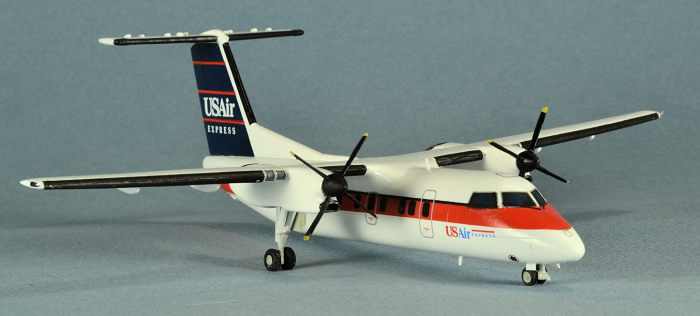 Even with
the advent of faster, quieter regional jets, Dash-8s are still well-represented
in regional airlines. On shorter legs, the jetsí speed advantage is negated and
the Dash-8 can turn a profit with fewer people on board. Production of the
Dash-8 Classics (-100, -200, -300) ended in 2008, and only the 70-passenger -400
series, now called the Q400, is still being manufactured. Even though Iím no
longer flying, many of the Dash-8s I flew over 20 years ago still are. Old 906
(N906HA, serial # 9), which was the highest-time Dash-8 in the world back in
1991, was retired in 2013. N941HA, the first Dash-8 I flew, was only just put
into storage in January 2018.
Even with
the advent of faster, quieter regional jets, Dash-8s are still well-represented
in regional airlines. On shorter legs, the jetsí speed advantage is negated and
the Dash-8 can turn a profit with fewer people on board. Production of the
Dash-8 Classics (-100, -200, -300) ended in 2008, and only the 70-passenger -400
series, now called the Q400, is still being manufactured. Even though Iím no
longer flying, many of the Dash-8s I flew over 20 years ago still are. Old 906
(N906HA, serial # 9), which was the highest-time Dash-8 in the world back in
1991, was retired in 2013. N941HA, the first Dash-8 I flew, was only just put
into storage in January 2018.
I enjoyed flying the Dash-8 during my time with Henson/Piedmont, and it will always be high on my list of favorite airplanes Iíve flown. I have frequent reminders of flying them, since several times a day, a Dash-8 flies over my house with its characteristic whistling drone, headed to Charlotte from my old crew base in New Bern, NC or one of my other old haunts, Pitt-Greenville airport.
| THE KIT |
This is currently the only readily-available 1/144 kit of the Dash-8-100. In the past, Sasquatch, Platz, and Nazca have also released kits of the Dash-8-100 in this scale, but all are out of production and hard to find. Eastern Express has announced an injection-molded Dash-8 series, but they havenít been released, yet. There is also the vaguely Dash-8-shaped 1/72 kit by Hobbycraft, which is best avoided.
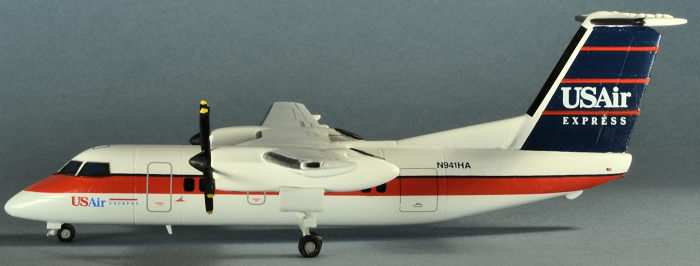 Welshís
kit includes a solid resin fuselage, with a separate radome, which allows the
forward fuselage to be drilled out and filled with lead. The engines and flap
fairings are cast with the wings. The kit also includes resin landing gear parts
and a pair of white metal props. No nose gear doors are provided. My kit had
laser-printed decals for two colorful Jazz Airlines aircraft.
Welshís
kit includes a solid resin fuselage, with a separate radome, which allows the
forward fuselage to be drilled out and filled with lead. The engines and flap
fairings are cast with the wings. The kit also includes resin landing gear parts
and a pair of white metal props. No nose gear doors are provided. My kit had
laser-printed decals for two colorful Jazz Airlines aircraft.
| CONSTRUCTION |
The kit requires very little cleanup before the large parts are joined. There are only a few small casting blocks to be trimmed off. I started by drilling a hole in the forward fuselage and radome and filling them with lead shot. The radome fits well and blends easily into the fuselage.
The wings donít fit the
fuselage very well, as if the person who made the masters didnít bother to test
fit them to see if they would fit the fuselage. The slot cut into the top of the
fuselage is too deep and too long, so the tabs on the wings that also form the
top of the wing-to-fuselage box are too thin and too short. I shimmed the
forward part of the wings with some .005 styrene sheet and the aft part with
some .010 to raise the wing up in line with the fuselage and to rotate the
engine nacelles forward slightly. I then filled the gap at the aft end of the
wings with some .030 styrene strip. The tabs on the wings on my kit were also
cast in such a way that the wings had more anhedral than a B-52, but this was
easily fixed in a couple of minutes by heating the resin in hot water and
bending the tabs up. The exhaust openings are
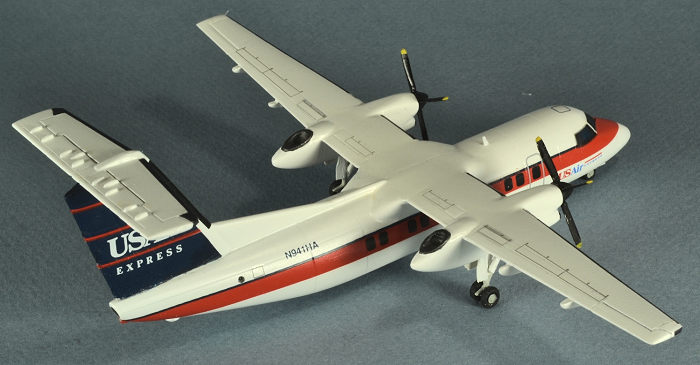 shallow
and the edges are thick, but I left them alone, for fear of damaging them and
creating more work for myself.
shallow
and the edges are thick, but I left them alone, for fear of damaging them and
creating more work for myself.
The sections of the engine nacelles forward of the wing are too blunt. They should taper more, to make a smooth transition into the spinners, something I didnít notice (along with the huge seam on the right nacelle!) until after it was too late to do anything about it. Had I noticed this before painting, I would have glued the spinners to the nacelles and sanded the forward ends of the nacelles down until they blended with the spinners.
The fairing that runs between the vertical stabilizer fillet and the top of the wing fairing should disappear smoothly into the top of the wing, instead of just stopping at the wing trailing edge. I used a little styrene blend it into the top of the wing. The horizontal stabilizer fit without any problems. The leading edge of the fairing that goes over the top-center of the vertical stabilizer needed a little reshaping. It should continue the sweep of the leading edge of the fin instead of sticking straight up like Herman Munsterís forehead. If you really want to get picky, on a parked Dash-8, the elevators should be in the full nose-down position. The gust lock on the aircraft was not unlocked until just before takeoff and was set upon exiting the runway, as part of the after landing flows.
Welsh forgot the tail bumper, but this was easily made by sanding a leftover chunk of resin casting block to shape. Finally, I drilled out the exhaust opening for the APU on the right side of the fuselage.
| COLORS & MARKINGS |
I painted the model with Tamiya white primer, which covers well and dries quickly with an eggshell finish. The Dash-8ís landing gear and wheels are painted light gloss gray, and the aerodynamic fairings on the main gear struts are usually white. Model Master Canadian Voodoo Gray is a good match for the gray landing gear parts.
The USAir Express liveries
came from an old set from Flight Path, the detail decals are from Nazca, and I
printed my own cabin windows. Neither the kitís nor the Nazcaís windshield
decals fit the model, so I had
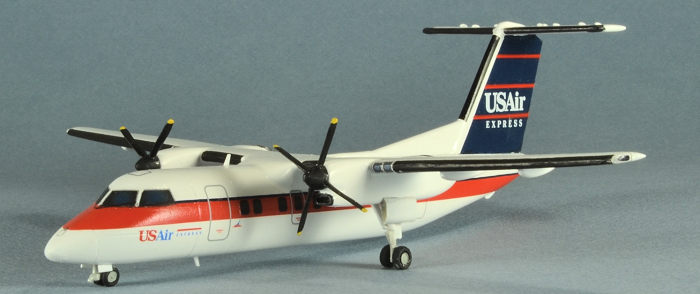 to do
some creative cutting on the kit decals to fix them. Flight Path includes
registration numbers and letters so one can build any Henson/Piedmont, CCAir, or
Allegheny Dash-8. The fuselage stripes were intended for the Sasquatch kit, so
they needed a little trimming to fit around the nose and tail. The decals were
also translucent, even on a white background, so I had to use a second sheet to
double-up the fuselage stripes and all of the tail decals. Iíve had this problem
with other Flight Path decal sheets in the past.
to do
some creative cutting on the kit decals to fix them. Flight Path includes
registration numbers and letters so one can build any Henson/Piedmont, CCAir, or
Allegheny Dash-8. The fuselage stripes were intended for the Sasquatch kit, so
they needed a little trimming to fit around the nose and tail. The decals were
also translucent, even on a white background, so I had to use a second sheet to
double-up the fuselage stripes and all of the tail decals. Iíve had this problem
with other Flight Path decal sheets in the past.
As previously-noted, the spinners donít match the forward part of the nacelles, so I just made some new spinners by chucking some bomb noses in a drill and sanding them to shape. On the PW-1XX series engines found on the Dash-8, EMB-120 Brasilia, and other types, the prop can only be brought out of feather if the engine is running and producing oil pressure, so I attached the kit propeller blades to the new spinners in the feathered position. The main gear struts seem barely up to the task of holding up the model, since they are so thin, but are much sturdier once assembled. I finished the model with nose gear doors, antennae, and drain masts made from styrene sheet. Note that the main gear doors should be attached to the port side of each nacelle.
| CONCLUSIONS |
This is a nice kit, and is a fun, relaxing project. I think Welsh have done a great job of capturing the look of the Dash-8, and the model just needs a little tweaking of the shapes here and there to make it a real gem.
| REFERENCES |
Airliners.net: http://www.airliners.net/
http://walkarounds.scalemodels.ru/v/walkarounds/avia/civil_and_sport_avia/dash-8-q300/ (This is a -300, but for our purposes, the only differences are the fuselage length and wingspan.)
My own rapidly failing memory.
3 April 2018
Copyright ModelingMadness.com
If you would like your product reviewed fairly and fairly quickly, please contact the editor or see other details in the Note to Contributors.